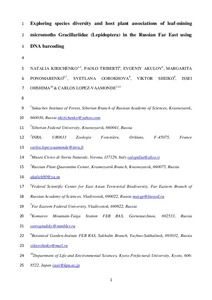Показать сокращенную информацию
Exploring species diversity and host plant associations of leaf-mining micromoths Gracillariidae (Lepidoptera) in the Russian Far East using DNA barcoding
| Автор | Kirichenko, N. | |
| Автор | Triberti, P. | |
| Автор | Akulov, E. | |
| Автор | Ponomarenko, M. | |
| Автор | Gorokhova, S. | |
| Автор | Sheiko, V. | |
| Автор | Ohshima, I. | |
| Автор | Lopez-Vaamonde, C. | |
| Дата внесения | 2020-01-20T07:58:15Z | |
| Дата, когда ресурс стал доступен | 2020-01-20T07:58:15Z | |
| Дата публикации | 2019 | |
| Библиографическое описание | Kirichenko, N. Exploring species diversity and host plant associations of leaf-mining micromoths Gracillariidae (Lepidoptera) in the Russian Far East using DNA barcoding [Текст] / N. Kirichenko, P. Triberti, E. Akulov, M. Ponomarenko, S. Gorokhova, V. Sheiko, I. Ohshima, C. Lopez-Vaamonde // Zootaxa. — 2019. — Т. 4652 (№ 1). — С. 1-55 | |
| ISSN | 11755326 | |
| URI (для ссылок/цитирований) | https://www.biotaxa.org/Zootaxa/article/view/zootaxa.4652.1.1 | |
| URI (для ссылок/цитирований) | https://elib.sfu-kras.ru/handle/2311/129428 | |
| Описание | Текст статьи не публикуется в открытом доступе в соответствии с политикой журнала. | |
| Аннотация | The Russian Far East (RFE) is an important hotspot of biodiversity whose insect fauna remains understudied, particularly its Microlepidoptera. Here we explore the diversity of leaf-mining micromoths of the family Gracillariidae, their distribution and host plant associations in RFE using a combination of field observations and sampling, DNA barcoding, morphological analysis and literature review. We collected 91 gracillariid specimens (45 larvae, 9 pupae and 37 adults) in 12 localities across RFE and identified 34 species using a combination of DNA barcoding and morphology. We provide a genetic library of 57 DNA barcodes belonging to 37 Barcode Index Numbers (BINs), including four BINs that could potentially represent species new to science. Leaf mines and leaf shelters are described and illustrated for 32 studied species, male or female genitalia as well as forewing patterns of adults are shown, especially for those species identified based on morphology. Three species, Micrurapteryx caraganella (Hering), Callisto insperatella (Nickerl), and Phyllonorycter junoniella (Zeller) are newly recorded from RFE. Five species previously known from some regions of RFE, were found for the first time in Amurskaya Oblast: Phyllonorycter populifoliella (Treitschke), Primorskii Krai: Ph. sorbicola Kumata and Sahkalin Island: Caloptilia heringi Kumata, Ph. ermani (Kumata) and Ph. ulmifoliella (Hübner). Eight gracillariid–plant associations are novel to science: Caloptilia gloriosa Kumata on Acer pseudosieboldianum, Cameraria niphonica Kumata on A. caudatum subsp. ukurundense, Parornix ermolaevi Kuznetzov on Corylus sieboldiana, Phyllonorycter ermani (Kumata) on Betula platyphylla, Ph. nipponicella (Issiki) on Quercus mongolica, Ph. orientalis (Kumata) and Ph. pseudojezoniella Noreika on Acer saccharum, Ph. sorbicola on Prunus maakii. For the first time we documented the “green island” phenotype on Phyllonorycter cavella (Zeller) mines on Betula platyphylla. Two pestiferous species have been recorded during our surveys: Micrurapteryx caraganella on ornamental Caragana arborescens in urban plantations in Amurskaya Oblast, and the lime leafminer Phyllonorycter issikii (Kumata), a species known to be native to RFE and invasive elsewhere in Russia and in European countries. A revised checklist of RFE gracillariids has been compiled. It accounts for 135 species among which 17 species (13%) are only known to occur in RFE. The gracillariid fauna of RFE is more similar to the Japanese fauna (49%), than to the fauna of the rest of Russia (i.e European part and Siberia) (32%). | |
| Тема | Asian part of Russia | |
| Тема | COI | |
| Тема | faunal checklist | |
| Тема | biogeography | |
| Тема | insect–plant interactions | |
| Тема | invasive species | |
| Тема | pests | |
| Тема | putative new species | |
| Название | Exploring species diversity and host plant associations of leaf-mining micromoths Gracillariidae (Lepidoptera) in the Russian Far East using DNA barcoding | |
| Тип | Journal Article | |
| Тип | Journal Article Preprint | |
| Страницы | 1-55 | |
| ГРНТИ | 34.15.23 | |
| Дата обновления | 2020-01-20T07:58:15Z | |
| DOI | 10.11646/zootaxa.4652.1.1 | |
| Институт | Институт экологии и географии | |
| Подразделение | Лаборатория биогеохимии экосистем | |
| Журнал | Zootaxa | |
| Квартиль журнала в Scopus | Q2 | |
| Квартиль журнала в Web of Science | Q3 |

